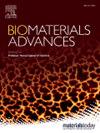A novel off-liver sinusoidal progenitor cells in supporting transplantable bioliver engineering
IF 5.5
2区 医学
Q2 MATERIALS SCIENCE, BIOMATERIALS
Materials Science & Engineering C-Materials for Biological Applications
Pub Date : 2025-05-24
DOI:10.1016/j.bioadv.2025.214358
引用次数: 0
Abstract
Liver transplantation is the only curative option for liver failure, which is currently limited by organ shortages. Although liver tissue engineering (LTE) with a strategy of decellularization/recellularization opens a new window to overcome this limitation, its challenges include the lack of specific seed cell sources and appropriate methods to support recellularization. In this preliminary study, both in vitro and in vivo experiments were performed. In vitro, we used novel off-liver progenitors of liver sinusoidal endothelial cells (LSECs) isolated from bone marrow mesenchymal stem cells (NG2/BMMSCs) and a method to establish transplantable biolivers in an advanced decellularized liver scaffold (rDLS). This partial liver scaffolds (rDLS) shows advantages over whole liver scaffolds (nDLS) and also maintains both microvascular network and naturally regenerative microenvironmental niche, enhancing effective recellularization of the NG2/BMMSCs compared to nDLS in reconstructing hepatic main architectures of endothelial, sinusoidal and biliary tree before seeding hepatic stem cells (MLpvNG2 and ratOv cells). The recellularized hepatic stem cells-mediated bioliver was subsequently induced in a 3D bioreactor-like system with three different conditioned media (CM1–CM3) for different culture durations. Importantly, the NG2/BMMSC-lined rDLSs effectively supported the functional bioliver engineering. In vivo, compared with control recipient pigs that underwent ∼90 % hepatectomy only, the recipients subjected to the same hepatectomy and received the bioliver presented greater survival durations. Overall, this study presents a new technology for fabricating a NG2/BMMSC-based transplantable bioliver that may become a promising treatment for liver failure.
一种支持可移植生物工程的新型离肝窦祖细胞
肝移植是治疗肝功能衰竭的唯一选择,目前受器官短缺的限制。尽管采用脱细胞/再细胞化策略的肝组织工程(LTE)为克服这一限制打开了新的窗口,但其挑战包括缺乏特定的种子细胞来源和支持再细胞化的适当方法。在本初步研究中,进行了体外和体内实验。在体外,我们使用了从骨髓间充质干细胞(NG2/BMMSCs)中分离的新型肝窦内皮细胞(LSECs)离肝祖细胞,并采用一种方法在高级脱细胞化肝支架(rDLS)中建立可移植的生物肝脏。这种部分肝支架(rDLS)比全肝支架(nDLS)具有优势,并且维持了微血管网络和自然再生的微环境生态位,与nDLS相比,在移植肝干细胞(MLpvNG2和ratOv细胞)之前重建肝脏内皮、窦和胆道树的主要结构时,增强了NG2/BMMSCs的有效再细胞化。随后,在三维生物反应器样系统中,用三种不同的条件培养基(cm2 - cm3)进行不同的培养时间,诱导再细胞化的肝干细胞介导的生物肝脏。重要的是,NG2/ bmmsc衬砌的rdls有效地支持了功能生物工程。在体内,与只接受90%肝切除术的对照受体猪相比,接受相同肝切除术并接受生物奥利弗的受体猪的生存时间更长。总的来说,本研究提出了一种制造基于NG2/ bmmsc的可移植生物肝脏的新技术,这可能成为治疗肝衰竭的一种有希望的方法。
本文章由计算机程序翻译,如有差异,请以英文原文为准。
求助全文
约1分钟内获得全文
求助全文
来源期刊
CiteScore
17.80
自引率
0.00%
发文量
501
审稿时长
27 days
期刊介绍:
Biomaterials Advances, previously known as Materials Science and Engineering: C-Materials for Biological Applications (P-ISSN: 0928-4931, E-ISSN: 1873-0191). Includes topics at the interface of the biomedical sciences and materials engineering. These topics include:
• Bioinspired and biomimetic materials for medical applications
• Materials of biological origin for medical applications
• Materials for "active" medical applications
• Self-assembling and self-healing materials for medical applications
• "Smart" (i.e., stimulus-response) materials for medical applications
• Ceramic, metallic, polymeric, and composite materials for medical applications
• Materials for in vivo sensing
• Materials for in vivo imaging
• Materials for delivery of pharmacologic agents and vaccines
• Novel approaches for characterizing and modeling materials for medical applications
Manuscripts on biological topics without a materials science component, or manuscripts on materials science without biological applications, will not be considered for publication in Materials Science and Engineering C. New submissions are first assessed for language, scope and originality (plagiarism check) and can be desk rejected before review if they need English language improvements, are out of scope or present excessive duplication with published sources.
Biomaterials Advances sits within Elsevier''s biomaterials science portfolio alongside Biomaterials, Materials Today Bio and Biomaterials and Biosystems. As part of the broader Materials Today family, Biomaterials Advances offers authors rigorous peer review, rapid decisions, and high visibility. We look forward to receiving your submissions!

 求助内容:
求助内容: 应助结果提醒方式:
应助结果提醒方式:


